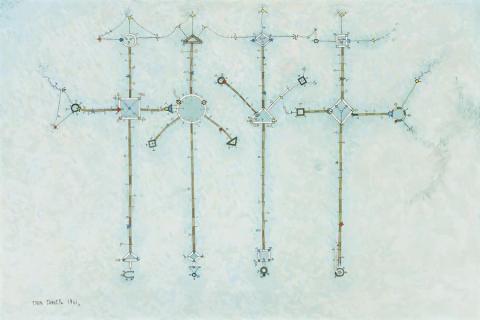LIGHTNING CONDUCTORS, 1961
EDWIN TANNER
oil on composition board
122.0 x 183.0 cm
signed and dated lower left: EDWIN TANNER 1961
titled verso: LIGHTNING CONDUCTORS No. 1
Charles Nodrum Gallery, Melbourne (label attached verso)
Wesfarmers Art Collection, Perth, acquired from the above in 1995(label attached verso)
Edwin Tanner Works 1952–1980, Monash University Gallery, Melbourne,1990, cat. 53
Edwin Tanner: Paintings from the 1950s to 1970s, Charles Nodrum Gallery, Melbourne, 28 October – 18 November 1995, cat. 7 (illus. in exhibition catalogue)
Edwin Tanner's is an art of silent eloquence in which harmony and humour play wittily on words and their realisation as images. Writing in the catalogue introduction to Tanner's 1976 retrospective exhibition, Patrick McCaughey observed, 'He himself has the intelligence and sensibility of a poet, at once lyrical and ironic, astringent and witty.'1 Tanner drew on a diversity of talents and interests. His Welsh background gave him a Celtic love of music and poetry, to which he added ships, philosophy, and flying planes. He excelled in mathematics, his several academic degrees including engineering. He was also a champion cyclist. In 1950 he was appointed engineer in charge of structural design at the Hydro-Electricity Commission, Hobart. His two 1954 paintings, Waterpower Persons and Professional Engineers draw on his career, their interest lying particularly in what they reveal about his character as seen in his art. Precision of layout is married to sharp lines, offset by cool colours, with superb draughtsmanship employed to narrate the theme of man's interrelationship with and dependence on machines. Independence and isolation go hand in hand, allied to a loneliness that came from shyness. His mastery of empty space is pregnant with possibilities, as revealed earlier in his controversial 1953 painting, The Public Servant in the collection of the National Gallery of Victoria, Melbourne. In a faceless, empty office the hands of a clock point to 5 pm! His humour was both serious and light-hearted.
The human presence in the form of figures gradually gave way to mechanical objects, as in Lightning Conductors 1961. The way was pathed by Madrigals c1960 (National Gallery of Victoria), and Assorted Souls in Storage 1962 (private collection), and continued through Fare Forward, Voyagers 1966-67 (private collection, Melbourne) into works of a more abstract vein. Engineers Going to Their Place of Employment 1963-64 (once in the collection of John and Sunday Reed) provides an interesting link with Lightning Conductors.2 As machines become more like humans, the latter metamorphose into things mechanical. Here, a chorus line of humanoid conductors of titillating linearity vibrate and twitter in conversation. Their characters are revealed through pose, gesture, and cheeky detail whereby Tanner softened his mordant bite. Lightning conductors are, of course, engineered to protect us against the forces of nature by earthing the lightning strike. Conductors also play an important role in music making. Tanner often listened to music while painting. It flows throughout his work, in this fantasy as a delightful capriccio. His is a very singular art.
1. McCaughey, P., 'Introduction', Edwin Tanner Retrospective 1976, The Age Gallery, Melbourne, 18-29 October 1976
2. Each of these paintings is illustrated in Barrie Reid, 'Maker and Signmaker - some aspects of the art of Edwin Tanner', Art and Australia, Sydney, vol. 9, no. 3, December 1971, pp. 213-223
DAVID THOMAS
